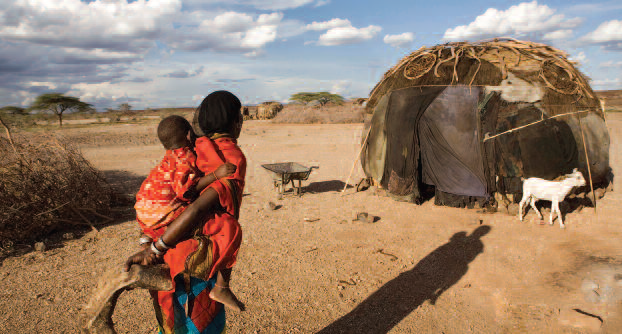Meeting demand peaks for CMAM in government health services in Kenya
 Regine Kopplow et al. Field Exchange 47, p3
Regine Kopplow et al. Field Exchange 47, p3
The humanitarian community and national governments increasingly recognise that early warning and response are more effective and less costly than late response. In practice, this remains challenging. Based on learning from the delayed response in the semi-arid lands (ASALs) of northern Kenya in 2010/2011, Concern Worldwide developed a model of CMAM surge support.
The CMAM surge model is based on the principle that early detection of acute malnutrition leads to improved treatment outcomes and fewer cases of severe acute malnutrition (SAM). The model prepares the health system to plan for, detect and respond efficiently to spikes in moderate acute malnutrition (MAM) and SAM prevalence and caseload. The model aims to strengthen the capacity of government health systems to effectively manage increased caseloads of acute malnutrition during predictable emergencies without undermining the health system, the provision of other services and on-going systems strengthening efforts.
The CMAM surge model is appropriate for contexts where:
- There are recurring, seasonal spikes in the prevalence of acute malnutrition, with risk of significant morbidity and mortality.
- Management of acute malnutrition is considered a standard government health service.
- Government health systems function to a moderate standard during non-emergency times and appropriate health system strengthening efforts are in place (where indicated).
The surge model contains a series of components that reinforce the WHO’s health system building blocks (service delivery, health workforce, information, medical products and technologies, financing, and leadership and governance).
In May 2012, the CMAM surge model was piloted with District Health Management Teams and health workers in three districts of Marsabit Country; it continues to date. The model will be evaluated later in 2014 to inform possible scale up or replication in other ASAL counties.
Lessons learned to date include:
- Acceptance of the model is closely related to its simplicity
- Incorporating community systems into the model is important and an area for further development
- Regular revision of the threshold is required given changes in local context
- Decentralised governance allows for flexible and localised decision making, an opportunity for the surge model.
Experience from the pilot also highlights that localised capacity is essential given the predictable nature of ‘nutrition’ emergencies and this will require both external agencies and government health staff to work differently. The CMAM surge model could facilitate the realigning of government and nongovernmental roles for more effective and cost effective provision of CMAM, allowing services to reach more people at the right time.

